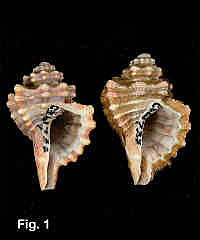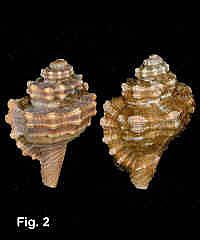

|
Cymatium
exaratum (Reeve,
1844)
Description:
Whorls strongly shouldered. Two strong spiral ribs on the shoulder, each
with a central groove; four single spiral ribs on the rest of the body
whorl, all separated by spiral threads. Suture to shoulder area weakly
spirally ribbed. Shoulder ribs heavily nodulose, 6-7 nodules on the body
whorl. Outer lip deeply grooved internally when immature, with about six
elongate denticles when mature. Columella with a tooth posteriorly, and
with lirae in large specimens. Colour fawn, covered with a thin, brown
periostracum when alive; interior white. Operculum oval.
Size:
Up to 60 mm, commonly 40 mm, in length.
Distribution:
All Australian states, Coral Sea, New Caledonia, New Zealand, Japan and
South Africa.
Habitat:
Intertidal on rocky shores, and down to 160 m. Uncommon.
Synonyms:
This species was known as Cymatium exaratum (Reeve, 1844) but
reverted to the earlier name of Cabestana tabulata (Menke, 1843).
However, recent work has shown that Menke's tabulata is actually
the shell that has been known as Cabestana waterhousei (Adams and
Angas, 1864). Thus the species returns to Cymatium exaratum
(Reeve, 1844).
Cymatium
zimara Iredale, 1929 is based on a specimen, probably subfossil,
dredged from Sydney Harbour.
Figs. 1,2: Broulee Beach, NSW (C.361773)
|